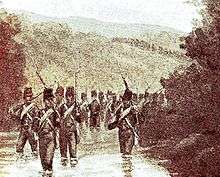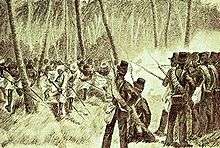Dutch intervention in Bali (1849)
| Dutch intervention in Bali (1849) | |||||||
|---|---|---|---|---|---|---|---|
 The Raja of Buleleng killing himself with 400 followers, in an 1849 puputan against the Dutch. Le Petit Journal, 1849. | |||||||
| |||||||
| Belligerents | |||||||
|
Lombok |
Buleleng Jembrana Klungkung | ||||||
| Commanders and leaders | |||||||
|
| I Gusti Ketut Jelantik † | ||||||
| Strength | |||||||
|
100 ships 3,000 sailors 5,000 well-trained soldiers | 33,000 men | ||||||
| Casualties and losses | |||||||
| 1,000s | |||||||
The Dutch intervention in Bali in 1849 was a major Dutch military intervention in Northern and Southern Bali, following two failed interventions, the 1846 intervention and the 1848 intervention. The Dutch used as a pretext Balinese salvage claims over shipwrecks, which were customary to the Balinese, but unacceptable under International law.[1]
Dutch naval expedition

The expedition arrived off Buleleng in 1849. It was a considerable force of the Royal Dutch East Indies Army, composed of 100 ships, 3,000 sailors, and 5,000 well-trained soldiers, including a majority of Dutch troops.[2][3]
The Dutch landed in Buleleng and marched on Singaraja, meeting with Balinese resistance at Jagaraga.[2] When they saw their situation was desperate, the Balinese committed the first Puputan, or mass-suicide, the Dutch would be given to witness in their conflicts with Bali.[2] In this encounter, the Dutch lost 34 men, and the Balinese thousands, including the wife of Jelantik, who was part of the Puputan.[3] I Gusti Ketut Jelantik and the ruler of Buleleng managed to escape to allied Karangasem.[3]
Southern Bali campaign
Reluctant to follow them overland, the Dutch returned to their ships and sailed to Southern Bali, where they landed in Padang Bai in order to attack Klungkung, nominal overlord of Buleleng.[3][3] In the meantime, however, the Dutch managed to establish an alliance with neighbouring Lombok against Karangasem, an old enemy of Lombok. Lombok troops were sent onboard Dutch ships, and ambushed Buleleng leaders. In this encounter both Jelantik and the Raja of Buleleng were killed, and the ruler of Karangasem committed ritual suicide.[2]

The Dutch continued their campaign into Klungkung, occupying Goa Lawah and Kusamba.[3] The climate and diseases were taking their toll on the Dutch troops, which were in a precarious position.[2] The Dutch suffered heavy casualties however when the sister of the ruler of Klunkung, Dewa Agung, led a night offensive against the Dutch in Kusamba, killing the commander Major General Michiels.[3] The Dutch were forced to retreat in haste to their ships, confronted by a force of 33,000 Balinese from Badung, Gianyar, Tabanan and Klungkung.[3] This resulted in a stalemate.[2][3]
Treaty

The death of Jelantik nevertheless represented a considerable blow to Balinese resistance.[2] Through the intervention of the trader Mads Lange and the ruler Kesinan of Badung, a new treaty was signed in July 1849, giving control over Buleleng and Jembrana to the Dutch.[2][3] The ruler of Lombok obtained control over Karangasem.[3] The Dutch had their headquarters in Singaraja, where a Dutch Controller ruled over the local Raja from 1855.[2]